
Marasmius is a genus of mushroom-forming fungi in the family Marasmiaceae. It contains about 500 species of agarics, of which a few, such as Marasmius oreades, are edible. However, most members of this genus are small, unimpressive brown mushrooms. Their humble appearance contributes to their not being readily distinguishable to non-specialists, and they are therefore seldom collected by mushroom hunters. Several of the species are known to grow in the characteristic fairy ring pattern.
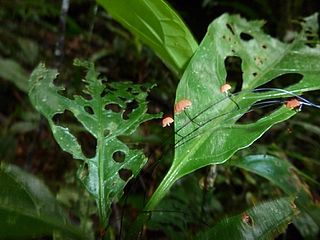
Marasmius crinis-equi is a plant pathogen. It is commonly known as the 'horse hair fungus', and appears on rainforest leaves as a wiry stipe with a delicate fruitbody. The cap of the fruitbody can be up to 4 mm in diameter, and is pale brown.
Marasmius tenuissimus is a species of agaric fungus in the large agaric genus Marasmius.
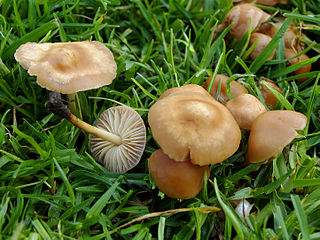
Marasmius oreades, also known as the fairy ring mushroom or fairy ring champignon, is a mushroom native to North America and Europe. Its common names can cause some confusion, as many other mushrooms grow in fairy rings, such as the edible Agaricus campestris and the poisonous Chlorophyllum molybdites.
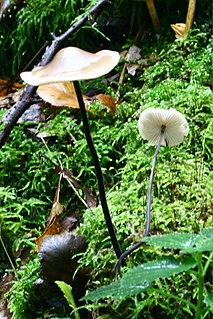
Mycetinis alliaceus, commonly known as the garlic parachute, is one of the larger mushrooms formerly in the genus Marasmius, having a beige cap of up to 4 cm and a long tough slender stipe. It emanates a strong smell of garlic, and this is the significance of the Latin species name, alliaceus. It is distributed throughout Europe, being fairly common in some areas and quite rare in others.

Collybia is a genus of mushrooms in the family Tricholomataceae. The genus has a widespread but rare distribution in northern temperate areas, and contains three species that grow on the decomposing remains of other mushrooms.

Mycetinis is a genus of fungus in the Omphalotaceae family, containing about eight species formerly classified in Marasmius.

Marasmius elegans, commonly known as the velvet parachute, is a species of fungus in the family Marasmiaceae. It has a reddish-brown cap, and a whitish stipe with white hairs at the base. It can be found in eucalypt forests in Australia.
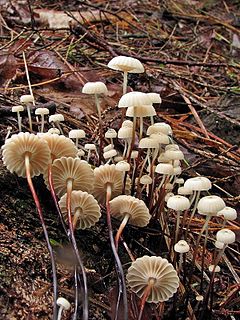
Marasmius rotula is a common species of agaric fungus in the family Marasmiaceae. Widespread in the Northern Hemisphere, it is commonly known variously as the pinwheel mushroom, the pinwheel marasmius, the little wheel, the collared parachute, or the horse hair fungus. The type species of the genus Marasmius, M. rotula was first described scientifically in 1772 by mycologist Giovanni Antonio Scopoli and assigned its current name in 1838 by Elias Fries.
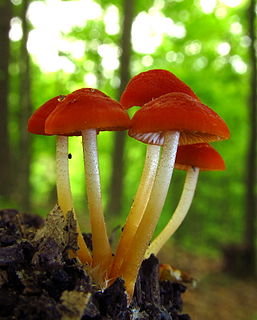
Marasmius sullivantii is a species of fungus in the family Marasmiaceae. The species was originally described by the French botanist Jean Pierre François Camille Montagne in 1856.

Marasmius bulliardii is a species of agaric fungus in the family Marasmiaceae. It was first described scientifically by French mycologist Lucien Quélet in 1878.
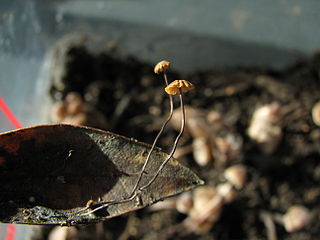
Cryptomarasmius is a genus of fungi in the family Physalacriaceae.

Marasmius fulvoferrugineus is a species of agaric fungus in the family Marasmiaceae. Described as new to science in 1976, it is found in the southeastern United States. The mushroom is frequently confused with Marasmius siccus, and microscopy is needed to reliably distinguish between them.
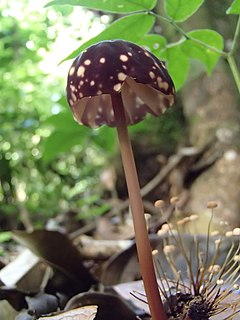
Marasmius amazonicus is a species of agaric fungus in the family Marasmiaceae. Described as new to science in 1904 by mycologist Paul Christoph Hennings, it is found in South America.

Marasmius siccus, or orange pinwheel, is a small orange mushroom in the Marasmius genus, with a "beach umbrella"-shaped cap. The tough shiny bare stem is pale at the top but reddish brown below, and the gills are whitish. The stem is 3–7 centimetres (1.2–2.8 in) tall and the cap is 0.5–2.5 centimetres (0.20–0.98 in) wide.
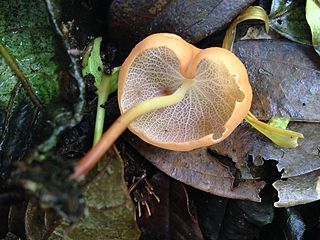
Marasmius cladophyllus is a species of fungus in the family Marasmiaceae. Found in South America and Central America, it was described as new to science by English mycologist Miles Joseph Berkeley in 1856. A characteristic feature of the mushroom is the prominent ventricose (vein-like) pattern of the gills.
Marasmius asiaticus is a species of agaric fungus in the family Marasmiaceae. Within the large genus Marasmius, it is classified in section Sicci. Known only from a single collection made in Mount Nuang Forest Reserve, it was described as new to science in 2009 by Tan and Dennis Desjardin under the name Marasmius distantifolius. This was later discovered to be an illegitimate homonym of a species named by William Alphonso Murrill in 1915, now known as Marasmiellus distantifolius. Armin Mešić and Zdenko Tkalčec proposed the new epithet asiaticus, referring to its distribution. The original epithet, which combined the Latin distans ("distant") and -folius ("leaf"), alluded to the distantly-spaced gills.
Marasmius munyozii is a species of fungus in the large agaric genus Marasmius. It is found in Chile, where it grows on dead grass leaves. The cap is white, with a pale cinnamon-ochraceous colored center and a slightly grooved margin. The fungus was described as new to science in 1969 by mycologist Rolf Singer.
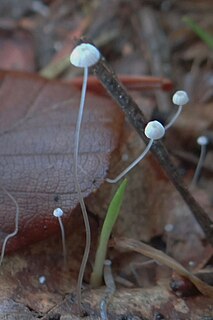
Rhizomarasmius setosus is a tiny whitish mushroom having a distinctive hairy stem. It has been given the vernacular name "Beechleaf Parachute".















